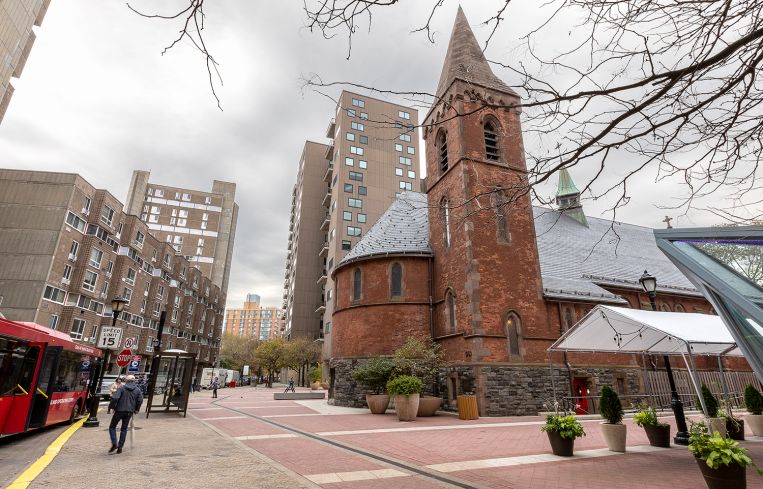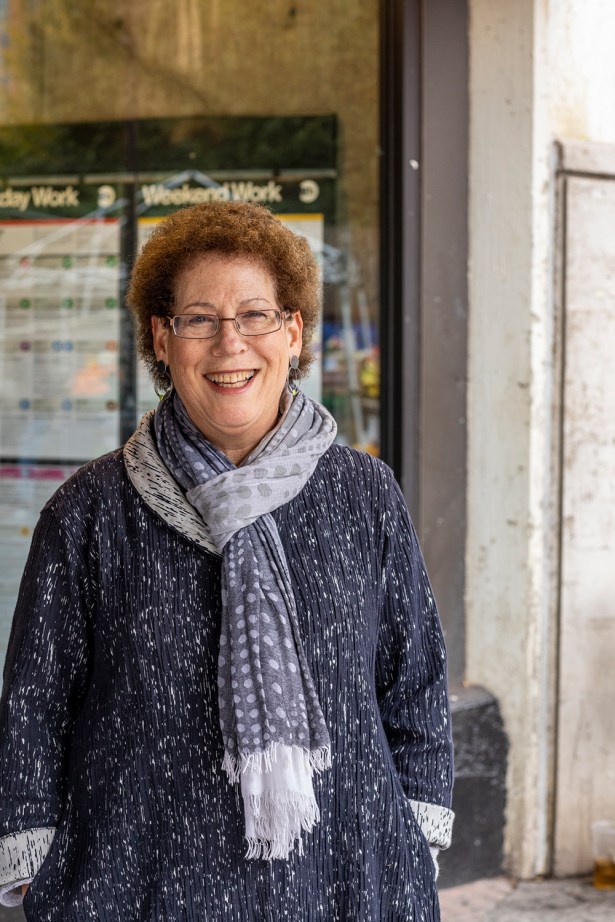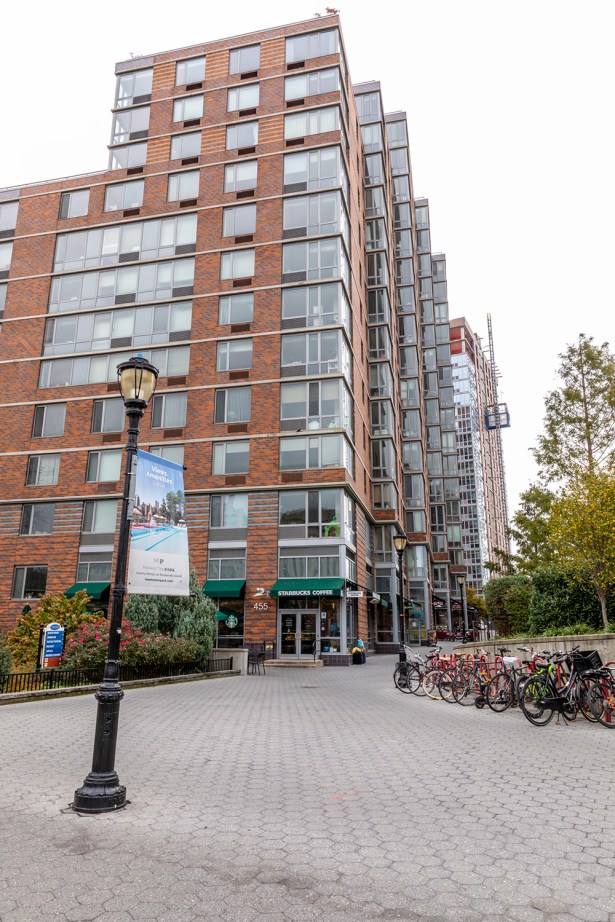Roosevelt Island Was Ed Logue’s Utopia. Would He Have Liked What It’s Become?
By Matt Grossman November 19, 2019 9:30 am
reprints
It’s the height of folly to conduct an interview in the middle of a New York City sidewalk on a weekday morning. But during a stroll earlier this month along Roosevelt Island’s quiet Main Street — downright pastoral by Big Apple standards — Lizabeth Cohen was coming in loud and clear.
“There’s something very peaceful about this place,” Cohen said, taking in the rows of mixed-use buildings that line the gently curving street’s mile-long course. “There’s all this open space, and it’s so much quieter than Manhattan. And [the retail] is not dominated by huge chains, like Hudson Yards is.”
That — as she has documented at length in a new book — was by design.
Cohen, a history professor at Harvard University, whose first book, “Making a New Deal,” won the field’s prestigious Bancroft Prize in 1991, has spent the last 14 years cataloguing the career of Ed Logue, the mastermind behind the residential enclave that sits tucked between Manhattan and Queens in the middle of the East River. Logue, who died in 2000 at the age of 79, planned Roosevelt Island’s development in the late ‘60s and early ‘70s as the crown jewel of a massive state-backed housing program.
Logue, who served as the head of the New York State Urban Development Corporation, took the initiative to turn the narrow island, which had been primarily a dumping ground for unsavory city institutions like insane asylums and prisons, into what he envisioned as a utopian mixed-income community. The UDC obtained a 99-year development lease in 1969 and Logue set to work drawing up designs for the island in exacting detail.
Those plans remain the island’s backbone even now that private developers have entered the scene. In 1996, Related Companies and Hudson Companies were the winners of a state bidding process for private development on the island. Since then, their nearly 2-million-square-foot Riverwalk development — seven of the planned nine buildings have already been completed — has added nearly 1,500 apartments to the island, some market rate and some affordable. And the $2 billion Cornell Tech campus has brought a significant new presence from an Ivy League university.

Still, the island remains an oddity of the public sector qua developer: an ever-lonelier relic of an era when governments weren’t shy about building big things.
It’s difficult to write about Logue without yielding to the temptation to compare him with one of the most divisive figures in New York City history, master builder Robert Moses. Moses, a generation older than Logue and a fellow Yale alumnus, ran his own ambitious development agency, the Triborough Bridge and Tunnel Authority, from Randall’s Island, another East River Island just a mile north of Logue’s domain.
Logue, in the end, succeeded on territory that eluded Moses, who had made two failed attempts to develop Roosevelt Island in the decades before Logue came to New York.
Still, Cohen said, it’d be a mistake to draw too direct a line between the two men.
“Logue was Robert Moses and the anti-Robert Moses all at once,” Cohen quotes a former Logue colleague, Lawrence Goldman, as saying. “He would think as large as Moses … but unlike Moses, he was as committed to social transformation as he was to physical building.”
When Cohen began researching Logue’s career in the early 2000s, she couldn’t have foreseen the relevance her work would have for New York City’s current political moment. But the fruits of her labor — a 500-plus-page biography of Logue called “Saving America’s Cities” that Farrar, Straus and Giroux published in October — couldn’t have been timelier.
Two years ago, New York City’s 421-a tax credit for housing lapsed for more than a year before being resurrected as Affordable New York, a hair-raising period of uncertainty for New York City multifamily developers that spawned renewed conversation about the government’s role in promoting renter-friendly housing markets.
And this year, Albany lawmakers drew fury from New York City developers when they passed a far-reaching new housing law aimed at making it much more difficult for landlords to deregulate rent-protected buildings.
All of a sudden, the same broad questions about government’s proper place in guiding housing markets that animated Logue’s ambitious plan for Roosevelt Island are, once again, reverberating through the halls of power.
That made a visit to Roosevelt Island with Cohen earlier this month a prime occasion to reflect on the island’s example. Tracking its evolution from centrally planned community to mixed-use destination is informative most of all because it provides a case study in the strengths and weaknesses of both government planning and private development.
“There’s sort of a natural check-and-balance philosophy to the place,” said Alexandra Kaplan, a project manager at Hudson Companies, which since the early 2000s has joined with Related as the force behind the island’s private apartment buildings. “It’s a true public-private partnership. That’s part of what has made it so successful.”
Related and Hudson are currently at work on their eighth and ninth private residential buildings on the island, but the companies emphasize that scrupulous attention to Logue’s broad vision for the space — if not his specifics — have guided their work throughout.
“Our development, at the end of the day, is additive to the original,” said Frank Monterisi, a Related Companies executive. “You look at Roosevelt Island and say, from the original thought, how can there be further development brought to the island to make it better?”
Cohen, who during our visit to the island professed a fondness for the heavy, brutalist UDC-built multifamily properties that sprang from Logue’s original plan, might disagree with Monterisi’s assessment that Related and Hudson’s buildings are a seamless fit. She grimaced at seeing that some of the developers’ newest construction, such as a project called Riverwalk Point, had an off-street drive for cars. Originally, Logue meant for the island to be mostly an auto-free zone.
“This feels really different, doesn’t it?” she asked, approaching the development. “Because there were no cars originally. There was no sense that you’d be arriving in a vehicle. It was just going to be, ‘You’re going to approach the building as a pedestrian.’ ”
More broadly, she suggested Logue would have been less than comfortable with the arrival of private developers in the first place, which, in bringing luxury tenants to the island alongside subsidized renters, have brought the beginnings of a class divide to the island.
“Logue was very proud of the fact that Roosevelt Island was a total piece of social engineering,” Cohen said. “As [planners of Logue’s era] were watching inequality grow — and boy, it was nothing then compared with today — there was a confidence that government interventions in the physical environment could make a huge difference in the way people lived.”
But elsewhere, Cohen was pleased to observe continuity with Logue’s original vision. Disembarking from the aerial tram, which connects the island to 59th Street in Manhattan, she was thrilled to notice a handful of tourists apparently setting off in the direction of Four Freedoms State Park, at the island’s southern tip. The small park, which features a monument to Franklin Roosevelt, for whom Logue rechristened the island, was commissioned by Logue in 1972 but didn’t open until 40 years later — more than a decade after Logue’s death.
She was also happy to see that a handful of historic sites predating Logue’s plan — which Logue preserved — remain intact. One example is the Chapel of the Good Shepherd, a church built on the island in 1889 as a place for the almshouse denizens who lived on the island at the time to worship. Under Logue’s plan, the chapel was converted to a more sublunary purpose, taking on a role as a community event space. That vision was alive and well last month, when posters advertised upcoming book talks and other community meetings in the building.
“This is literally an island unto itself, with its own culture,” Ben Kallos, the New York City councilman who represents Roosevelt Island, told Commercial Observer. “This is a small-town environment with about 12,000 residents. Everyone knows everyone.”
But private development has also brought radical change, including — in the form of Manhattanesque rents for market-rate units — a taste of the larger city’s housing market from which Logue had hoped the island could provide sanctuary. Today, for instance, rental rates for a market-rate studio in The Octagon, a private building at the island’s north end, have approached $3,000 per month, according to data from StreetEasy. And two-bedroom apartments in Riverwalk Point have been leased for more than $4,800. BMWs and Range Rovers were not an uncommon sight among the cars parked near those developments’ entrances.
“Even though we’re responding to market forces, we’re operating around some basic elements of Roosevelt Island,” Hudson’s Kaplan said. “We’re seeing a lot of families [in our developments], and that’s a product of supplying really high-quality housing at a price point that’s less than the Upper East Side.”
Suri Kasirer, whose firm represented Cornell Tech to island residents and local politicians during its development process, said the island’s strong — at times forceful — community was in evidence throughout.
“Those years of work were so intense,” Kasirer recalled. “It’s such an organized, engaged community. We couldn’t just show up. We really needed to build those relationships.”
At one early meeting, she added, “I almost felt we were getting tomatoes thrown at us.” In the end, community engagement led to significant concessions during the construction process, including an arrangement for materials to be shipped to the island by barge instead of via more disruptive trucking.
During the visit, Cohen was interested in the question of how well Logue’s clarion call for social and racial diversity has persevered on the island. Under Logue’s plan, 70 percent of the island’s stock would be set aside for middle-income residents, with the balance meant to house the poor and the elderly. He also hoped to rent at least 30 percent of the island’s apartments to minorities, a goal that came from his desire that no one development would be too strongly associated with a particular ethnic group.

The U.S. Supreme Court’s 1978 decision in Regents of the University of California v. Bakke has since strictly limited governments’ abilities to target racial quotas that way. That’s a change that’s mirrored the direction of government housing policy writ large, which has grown far less activist in the decades since Logue was in his prime.
“Compared with looking back in time to when government actually built things, the current state of affairs is that government lays the groundwork and creates the framework and puts the incentives forward. The government communicates to developers, ‘Here’s what we think should happen,’ and asks the market to respond,” Monterisi said. “When you look at any place around the city, it’s all about public-private partnership.”
In Monterisi’s view, developers’ responsiveness to incentives on Roosevelt Island has borne out as a key advantage compared with the earlier era of government-driven development, arguing that despite the coming of wealthier renters, the island’s community is as strong as ever.
“There’s a healthy incremental approach today, compared with when government comes in and plops something down,” Monterisi said. “It’s a bit more of a market-based concept and a community-based concept.”
Separately, Monterisi and Cohen both noted an irony in the course of the island’s history. Logue had attempted to achieve diversity by means of central planning. But since the state, through its local agency, the Roosevelt Island Operating Corporation, opened the enclave to more private development, the arrival of market-rate housing has made the island — for better or worse — more diverse than Logue’s state agency could have achieved on its own.
After all, Logue hadn’t envisioned a Roosevelt Island outpost of an Ivy League school, but Cornell Tech has now opened shop near the island’s southern tip. Nor had he planned for a ritzy indoor tennis facility, but that facility too — the Roosevelt Island Racquet Club — has diversified the crowd that pays the island weekly visits
“The fact that there’s now the university here, the market rate housing, that there’s more recreation: That is still consistent with what [Logue] wanted,” Cohen said.
Judging by a stroll past one of the public schools Logue built on the island, his legacy has not disappeared. Cohen noted that the kids running around in the courtyard during recess there were a diverse bunch — racially at least.
The scene was a rebuke to an argument Logue heard from developer Richard Ravitch in the 1970s: that Logue had better persuade a ritzy Upper East Side private school such as Dalton to start an outpost on the island, because white families would surely never send their children to its public schools.
Cohen recalled Logan’s reaction: “Logue basically said, ‘That’s not my idea. And this is my island, not your island. So get off.’”



